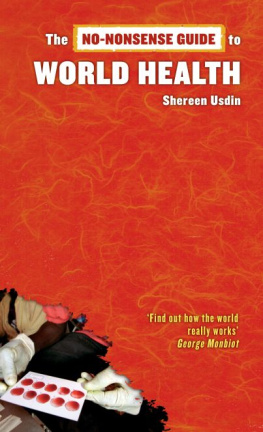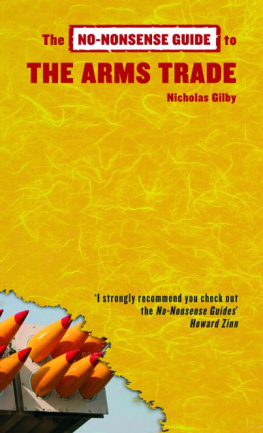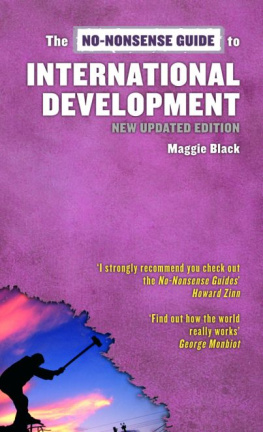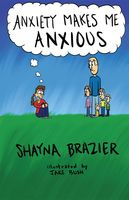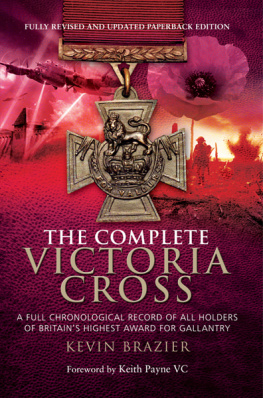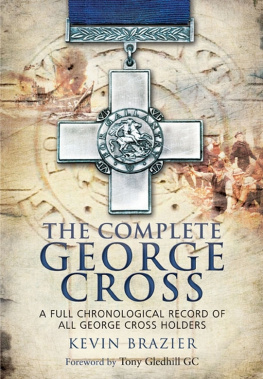The NO-NONSENSE GUIDE to
WORLD HISTORY
Publishers have created lists of short books that discuss the questions that your average [electoral] candidate will only ever touch if armed with a slogan and a soundbite. Together [such books] hint at a resurgence of the grand educational tradition Closest to the hot headline issues are The No-Nonsense Guides. These target those topics that a large army of voters care about, but that politicos evade. Arguments, figures and documents combine to prove that good journalism is far too important to be left to (most) journalists.
Boyd Tonkin,
The Independent,
London
About the author
Chris Brazier has been a New Internationalist co-editor since 1984. His other books include Vietnam: the Price of Peace (Oxfam 1992), the anthology Raging Against the Machine (New Internationalist 2003) and Trigger Issues:Football (New Internationalist 2007). Since 2001 he has also been principal writer for UNICEFs annual flagship report The State of the Worlds Children. www.newint.org
The NO-NONSENSE GUIDE to
WORLD HISTORY
Chris Brazier
New Internationalist
The No-Nonsense Guide to to World History
Published in Canada by
New Internationalist Publications Ltd
2446 Bank Street, Suite 653
Ottawa, Ontario
K1V 1A8
www.newint.org
and
Between the Lines
401 Richmond Street West, Studio 277
Toronto, ON
M5V 3A8
www.btlbooks.com
First published in the UK by
New Internationalist Publications Ltd
55 Rectory Road
Oxford OX4 lBW
New Internationalist is a registered trade mark.
Chris Brazier/New Internationalist 2011
First printed 2001. Revised edition 2002. Reprinted 2003, 2004.
New edition 2006. Reprinted 2007.
This third edition published in 2011.
This edition not to be sold outside Canada.
Cover image: Gallo Images/Getty
All rights reserved. No part of this publication may be photocopied, reproduced, stored in a retrieval system, or transmitted in any form or by any means, electronic, mechanical, recording, or otherwise, without the written permission of Between the Lines, or (for photocopying in Canada only) Access Copyright, 1 Yonge Street, Suite 1900, Toronto, Ontario, M5E 1E5.
Series editor: Chris Brazier
Design by New Internationalist Publications Ltd
Cataloguing data available from Library and Archives Canada.
ISBN 978-1-771131-01-8 (epub)
ISBN 978-1-771131-02-5 (PDF)
ISBN 978-1-926662-49-7 (print)
Between the Lines gratefully acknowledges assistance for its publishing activities from the Canada Council for the Arts, the Ontario Arts Council, the Government of Ontario through the Ontario Book Publishers Tax Credit program and through the Ontario Book Initiative, and the Government of Canada through the Canada Book Fund.
CHRIS BRAZIER is right; a historian confronting the task of a history of the world in 40,000 words would gasp. No professional is presented with this challenge, even in the most general first year outline course. Chris moves easily from the slimy origins of organisms to asymmetrical power relations in the 21st century. His history is a New Internationalist history, linked with other themes being pursued in the No-Nonsense Guide series. He insists, as do many contemporary historians, that we should break away from Euro-centric interpretations and narratives. He demands that womens history be placed center stage. He reminds us constantly that in most epochs, and most cultures, there have been sharp inequalities: humankind faces this dilemma as starkly, perhaps more so, at the beginning of the 21st century. His history includes a record of extraordinary human movement and migration, a phenomenon with a long pedigree that remains central to contemporary concerns in a world with bounded nation states. Although he does not offer an environmental interpretation of history, he ends with a plea for environmental consciousness in facing core issues of humankinds reciprocal relationship with nature. We remain, after all, and before anything else before our color or culture or religion a mammal species dependent upon the natural world.
The human species is, however, unique, not least in its self-criticism. Chris Braziers history is critical of many aspects of the past, and also of its interpretation by previous generations of Europeans. Here I agree with him, and this capacity to change and reassess must remain one of our cultures great strengths. There are also points where I may disagree with Chris. Everywhere he wishes to look behind the relics of pyramids, monuments and palaces and to investigate the human cost and the work involved. Yet his treatment of pre-colonial African empires is perhaps too celebratory, somewhat in contrast to his emphasis on hierarchy and exploitation in the pre-Columbian Latin America. Sometimes he does not correct enough for me. I can see why he has to focus on empires and politics in this history, in order to provide some chronological framework across vast swathes of time, but I would like to hear more loudly the voices of plain people. And perhaps I am less troubled by the future, the opportunities offered by the modern world and technology, and more convinced of the benefits of uneven, sometimes faltering, global democratization.
Historians are a querulous bunch and are taught to be so. On no account should we be protected from brave generalizers who seek to make sense of the whole, when so many professionals cultivate close vision. History must inevitably be a subject for contestation, because it is always to some degree ideological in nature, and because it is so important for understanding, justifying or changing the present. This book is a challenge. It is vivid, informal and informative. Let us give it to schoolkids and students to read; lets listen to their comments. They will have their own interests which they would wish to find mirrored in the past. We must find ways to cater for them and this kind of text is a good place to start. Perhaps every professional historian should be required to write a history of the world in 40,000 words nothing would be more conducive to humility.
Professor William Beinart
St Antonys College
University of Oxford
CONTENTS
THE BRIEFER a history of the world sets out to be, the more ambitious it inevitably is. Some people write entire learned tomes about postage stamp design between 1864 and 1902. So how can I possibly condense the whole history of the world into such a limited space? Only by being very selective and sweeping. But I think there is a real value to this. Many historians have an intimate knowledge of their particular nook or cranny but may not always stand back to try and see the great building in its entirety.
Indeed, most of us know bits and pieces of history without ever knowing how they fit together. This came home to me when I was in the attic sorting through boxes of papers from my own ancient past. I came across the history projects I did at school. And almost all were about wars pages and pages on the disposition of the Duke of Marlboroughs troops at the Battle of Blenheim, whole chapters on the different phases of the Napoleonic Wars.
The energy I put into all this came from a certain fascination with the past I wanted to be transported back into a bygone age to see how its people really lived. But what a waste of that enthusiasm to have it expended on military campaigns in a tiny corner of Europe when all the world and time was there for the tasting School taught me next to nothing about the histories of Asia, Africa and Latin America. The odd queen aside, I learned nothing at all about womens history, which has been submerged for thousands of years beneath the endless flow of wars and politics and is only now beginning to surface. And I was taught very little about the everyday experience of ordinary people throughout the ages, the ones who actually died building the Pyramids or plowed the fields beneath the castle.





